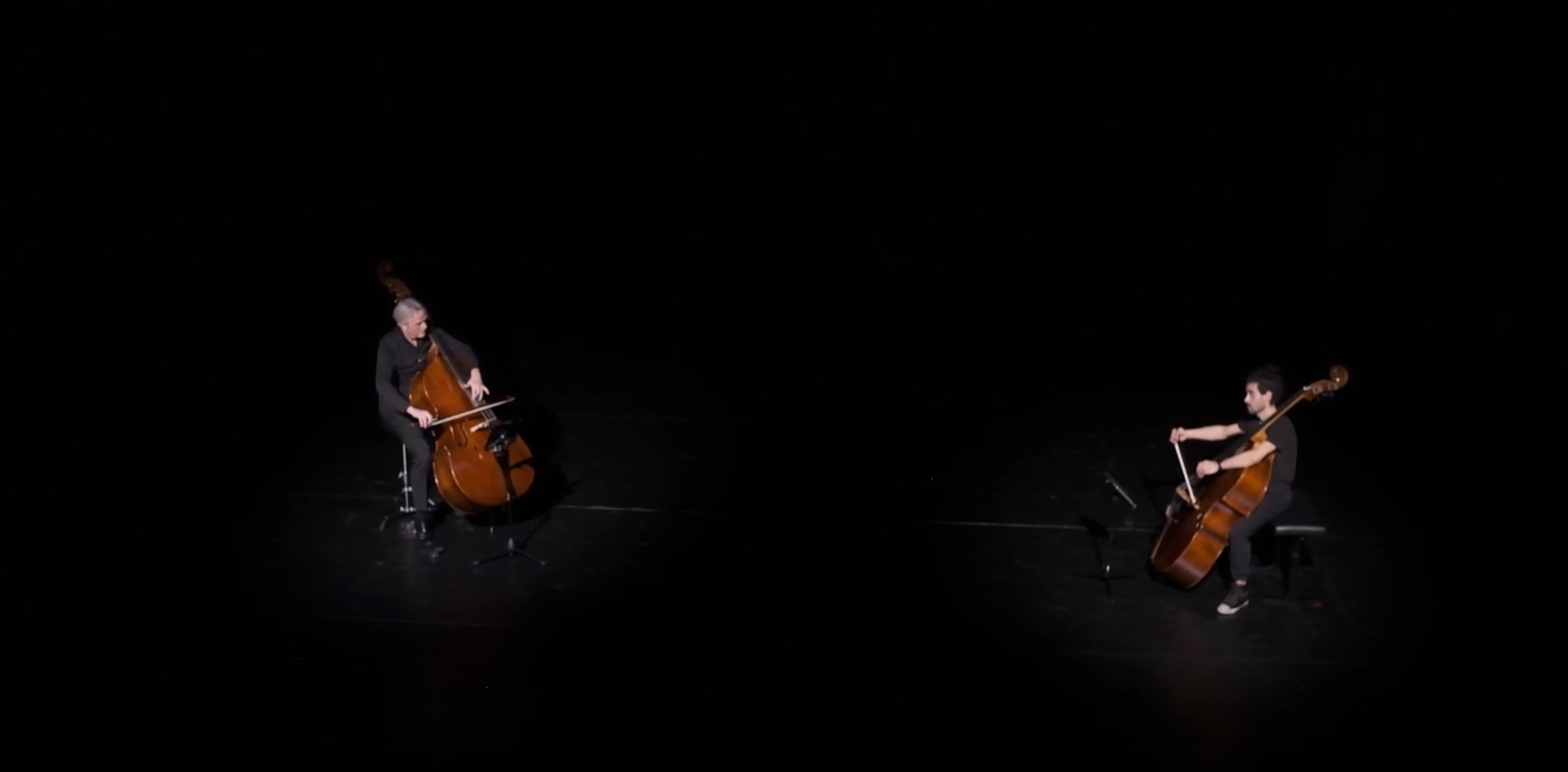Javad Javadzade asked for a piece for two double basses and electronics. He wanted to be able to perform it alone also, so ended up having to trigger electronics way more than is usually acceptable. Be careful what you wish for, I suppose. It was a good test of current digital resources as the performance computer was on stage and Javad’s bluetooth pedal (which would usually just turn score pages on a tablet) was used to trigger things in a max patch as well as the score pages on a local network. It was all a bit nerve-wracking for me as if something went wrong (what? bluetooth is just so robust!) then there was nothing I could do.
Score available here.
programme note
great symphony in c (in five movements), for two double basses and electronics, was written for Javad Javadzade and Niek de Groot. These two musicians use different open-string tunings: Javad in fifths from low C, like a cello; Niek the more usual fourths from low E. This offers all sorts of possibilities for single and double-harmonic combinations and these are the mainstay for three out of the five movements of my piece.
The title alludes, amongst other things, to Schubert’s Ninth symphony, with its grand opening horn melody. This was bold and perhaps risky instrumentation for its time, given that brass instruments were in a transition period between natural instruments that used transposition crooks and those which used valves. For instance, the fourth note of Schubert’s melody, middle A, was not playable on the natural instruments, so unless new valve instruments were available it would have been played as the seventh partial of the C fundamental, tuned down with hand and lip, with all the attendant risk of not quite making it (in tune). In quoting this melody across the two differently tuned basses, my piece plays with the divergent frequencies arising out of playing ostensibly the same pitches as different harmonics, e.g. a high C as the 16th partial of the low C string, or the 7th partial of the D string–theoretically at least almost 10Hz, or 31 cents apart.
The five movements of my title refer not only to the actual separate movements which make up this work but also to five stage movements: starting far apart, and ideally invisible to the audience, the duo eventually meets mid-stage, close enough to play each others’ instruments in fact—at least the open strings, with the lowest three forming a lovely sub-bass C Major triad.
Each movement has its own subtitle: 1. hello again franz, 2. sniping from the sidelines, 3. double harmonic bliss, 4. this’ll embarrass ya, and 5. this is not what arnold meant. Furthering the connection to the symphony, which is of course meant only tongue-in-cheek, the fourth movement is a dance, though by no means a tame minuet and trio—a scherzo is much more apt here, as it was so often in the works of Schubert himself, including his Ninth Symphony in C, the Great, though we could argue I take the joke far too far here.
programmtext
great symphony in c (in five movements), für zwei Kontrabässe und Elektronik, wurde für Javad Javadzade und Niek de Groot geschrieben. Diese beiden Musiker verwenden unterschiedliche Stimmungen der offenen Saiten: Javad in Quinten vom tiefen C, wie ein Cello; Niek die übliche Quarten vom tiefen E. Dies bietet alle möglichen Möglichkeiten für einfach- und doppelharmonische Kombinationen, und diese sind für drei der fünf Sätze meines Stücks die Grundlage.
Der Titel spielt unter anderem auf Schuberts neunte Sinfonie, mit ihrer großen Hornmelodie, an. Für die damalige Zeit war dies eine kühne und vielleicht riskante Instrumentierung, da sich die Blechblasinstrumente in einer Übergangsphase zwischen natürlichen Instrumenten, die Ansatzrohreverwendeten, und solchen, die Ventile hatten. Zum Beispiel war die vierte Note von Schuberts Melodie, das mittlere A, auf natürlichen Instrumenten nicht spielbar, so dass sie, solange keine neuen Ventilinstrumente vorhanden waren, als siebter Teilton des C-Grundtons gespielt, mit Hand und Lippe nach unten gestimmt und mit dem Risiko, es nicht ganz zu schaffen oder gut zu intonieren. Indem ich diese Melodie über die beiden unterschiedlich gestimmten Bässe zitiere, spielt mein Stück mit den abweichenden Frequenzen, die sich aus dem Spiel der scheinbar gleichen Tonhöhen als verschiedene Obertöne gespielt werden, z. B. ein hohes C als 16tel-Teilton der tiefen C-Saite oder der 7. Teilton der D-Saite – theoretisch zumindest fast 10Hz, oder 31 Cent auseinander.
Die fünf Sätze meines Titels beziehen sich nicht nur auf die eigentlichen einzelnen Sätze die dieses Werk ausmachen, sondern auch auf fünf Bühnenbewegungen: Das Duo beginnt weit voneinander entfernt, und im Idealfall unsichtbar für das Publikum, trifft sich aber schließlich in der Mitte der Bühne, nahe genug, um die Instrumente des anderen zu spielen – zumindest die leeren Saiten, wobei die untersten drei Saiten einen schönen C-Dur-Dreiklang im Subbass bilden.
Jeder Satz hat seinen eigenen Untertitel: 1. hello again franz, 2. sniping from the sidelines, 3. double harmonic bliss, 4. this’ll embarrass ya und 5. this is not what arnold meant. Eine Vertiefung der Verbindung zur Sinfonie – die natürlich nur augenzwinkernd gemeint ist – ist der vierte Satz, ein Tanz, wenn auch keineswegs ein zahmes Minuett und Trio – ein Scherzo ist hier viel passender, wie so oft in den Werken von Schubert selbst, einschließlich seiner Neunten Symphonie in C, der Großen, obwohl wir schon argumentieren könnten, dass ich hier den Witz ein wenig zu weit treibe.

Leave a Reply